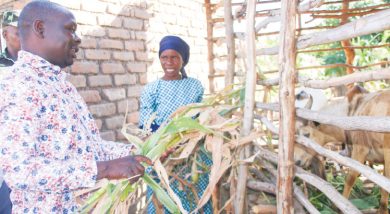Cashing on sunshine
When Edson Kanthenga bought his first mobile phone three years ago, he found himself walking over seven kilometres to recharge it.
“I used to leave home early in the morning to take the phone to Mbera or Chiyendausiku. Sometimes, I would spend the entire day there because many people were waiting to charge theirs as well,” says the 36-year-old shop owner.
Kanthenga and his neighbours in Kanjovu Village, Traditional Authority Sawali, also endured the long walk to get haircuts. The time wasted travelling to get services that need electricity could have been used for income generating activities, including farming or doing businesses.

Today, Kanthenga’s life has changed for the better since he acquired a solar power system with savings from the shop.
The system, worth K150 000, comprises a 100-watt solar panel, a battery, five chargers and an inverter.
The man is the talk of his village as people now charge phones in his shop. He has also opened a barbershop.
“I make at least K100 000 a month,” says Kanthenga.
There are two electric shavers in his barbershop.
“After a busy day, I sleep in full lights as if I am in the city. I feel better than before,” he brags, smiling.
Just a tenth of the population has access to power supplied by Electricity Supply Corporation of Malawi (Escom).
Solar energy has become a game-changer for households excluded from the grid, especially in rural areas where about 80 percent of Malawians live.
It is estimated that over 5 million Malawians have mobile phones, but without electricity to charge batteries.
The rural dwellers are disproportionately affected by hardships faced by 90 percent of the population without electricity.
Abundant energy People in Kanjovu Village are left behind at a time sustainable development goals to end poverty by 2030 challenges government to ensure everyone uses clean, sustainable and affordable electricity.
Government has embarked on Rural Electrification Programme to reduce the energy gap in remote trading centres.
However, solar energy remains a flexible alternative of powering communities with unmet demand for electricity in areas where rural electrification could be costly and slow.
Using solar panels to capture and convert sunlight and heat to electricity is reducing the burdens rural populations face when it comes to lighting, charging phones, accessing news and running businesses.
Solar energy is underultilised, although it is an abundant resource. The International Renewable Energy Agency (Irena) estimates that only 720 000 people in the country have access to solar energy.
Like SDG7, the New Partnership for Africa’s Development (Nepad), Africa’s development blueprint, recognises the need for countries to boost access to cheaper and reliable energy for socio-economic prosperity.
The International Monetary Fund (IMF) estimates that more than half of the country’s population live below the poverty line and 25 percent face extreme poverty.
Peter Mango is the director of Clean Energy Engineering, a non-profit organisation which strives to scale up access to renewable energy in remote communities.
He believes solar power helps rural communities see and unlock doors out of poverty.
He says: “For this country to develop, there is need to embrace productive use of solar power, especially in the rural areas. Solar energy is the fastest and cheapest way to light up rural areas,” he says.
Project Concern International (PCI) business development officer Thomas Ngulube says although electricity is a basic necessity for rural communities, the cost of buying and installing solar systems remains a huge setback for many people, especially the rural poor.
He states: “Not many people in the rural areas can afford solar equipment. Government should subsidise solar energy systems just as it does with fertiliser subsidy or malata subsidy.
“It can also engage banks and other finance institutions to guarantee access to loans for off-grid energy consumers who can’t afford solar solutions.”
“The solar energy sector needs more support for companies that offer long lasting products and quality-oriented installation services,” he added.
Light at last
SDG7 seeks to ensure universal access to affordable, reliable and modern energy by 2030.
In line with the global goals to end poverty, Malawi Growth and Development Strategy (MGDS) III envisions the country reducing the frequency of lengthy blackouts and increased access to reliable and affordable electricity in “rural and other targeted areas”.
According to the World Bank, more people could afford solar power if government removed barriers, such as high import duties, that increase the cost of panels.
Spokesperson for the Ministry of Natural Resources, Energy and Mines Sangwani Phiri said government is implementing several projects to boost access to solar power in the rural communities and many companies have expressed interest to come and invest in renewable energy for rural areas. n





